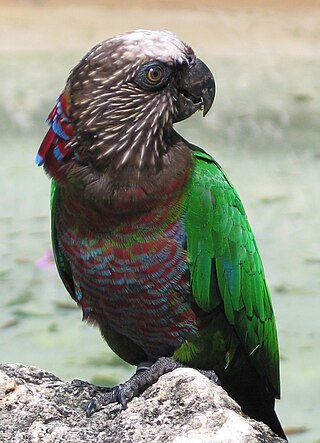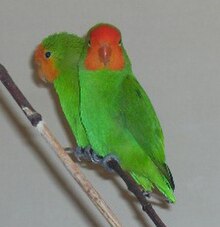
Lovebird is the common name for the genus Agapornis, a small group of parrots in the Old World parrot family Psittaculidae. Of the nine species in the genus, all are native to the African continent, with the grey-headed lovebird being native to the African island of Madagascar.

The blue-crowned hanging parrot is a parrot species endemic to southern Burma and Thailand, Malaya, Singapore, and Indonesia. These parrots are 12cm in height and weight 28g and have a longevity of 14 years. They are recognized by their green plumage, black beak and characteristic blue feathers arranged like a crown on their head.

The red-fan parrot, also known as the hawk-headed parrot, is a New World parrot hailing from the Amazon Rainforest. It is the only member of the genus Deroptyus.

The blue-and-yellow macaw, also known as the blue-and-gold macaw, is a large South American parrot with mostly blue top parts and light orange underparts, with gradient hues of green on top of its head. It is a member of the large group of neotropical parrots known as macaws. It inhabits forest, woodland and savannah of tropical South America. They are popular in aviculture because of their striking color, ability to talk, ready availability in the marketplace, and close bonding to humans. They can also live for 65–70 years.

The black-billed amazon is a parrot endemic to Jamaica. Sometimes called the black-billed parrot, this amazon parrot is mostly green with small patches of red on the wing and sometimes flecked on the head. Its bill makes it easy to separate from most other amazons, including the yellow-billed amazon, which also lives in Jamaica. It is the smallest Amazona parrot at 25 cm (10 in).

The red-shouldered macaw is a small green South American parrot, a member of a large group of Neotropical parrots called macaws. The species is named for the red coverts on its wings. It is the smallest macaw, being 30–35 cm (12–14 in) in length - similar in size to the Aratinga parakeets. It is native to the tropical lowlands, savannah, and swamplands of Brazil, the Guianas, Bolivia, Venezuela, and far south-eastern Peru. It has two distinct subspecies, the noble macaw and the Hahn's macaw, and a possible poorly distinct third subspecies that has longer wings, but is otherwise similar to the noble macaw. The Hahn's subspecies is named for German zoologist Carl-Wilhelm Hahn, who in 1834 began compiling Ornithologischer Atlas oder naturgetreue Abbildung und Beschreibung der aussereuropäischen Vögel.

The lesser vasa parrot or black parrot is a black coloured parrot endemic to most of Madagascar. It is one of four species of vasa parrots, the others being the greater vasa parrot, the Seychelles black parrot, and the Comoros black parrot. The latter two were formerly considered conspecific with the lesser vasa parrot.

The red-breasted parakeet is a parrot native to Southeast Asia. It is among the more widespread species of the genus and is the species which has the most geographical variations. It is easily identified by the large red patch on its breast. An alternative name is the moustached parakeet depending on subspecies. Most of the subspecies are confined to minuscule islands or a cluster of islands in Indonesia. One subspecies occurs in the Andaman islands, and one subspecies occurs in continental Southeast Asia and partly extending to northeastern parts of South Asia along the foothills of the Himalayas. Some of the island races may be threatened by the wild bird trade. The nominate race, which occurs in Java, is close to extinction.

The chestnut-fronted macaw or severe macaw is one of the largest of the mini-macaws. It reaches a size of around 45 cm (18 in) of which around half is the length of the tail.

The red-lored amazon or red-lored parrot is a species of amazon parrot, native to tropical regions of the Americas, from eastern Mexico south to Ecuador where it occurs in humid evergreen to semi-deciduous forests up to 1,100 m altitude. It is absent from the Pacific side of Central America north of Costa Rica. Not originally known from El Salvador, a pair - perhaps escaped from captivity - nested successfully in 1995 and 1996 in the outskirts of San Salvador and the species might expand its range permanently into that country in the future. This species has also established feral populations in several California cities.

The horned parakeet is a species of parrot in the genus Eunymphicus, in the family Psittaculidae. It is a medium-sized parrot endemic to New Caledonia. It is called "horned" because it has two black feathers that protrude from the head and have red tips.

Eupsittula canicularis, also known as the orange-fronted parakeet, orange-fronted conure, half-moon conure or Petz's conure is a Vulnerable species of bird in subfamily Arinae of the family Psittacidae, the African and New World parrots. It is found from western Mexico to Costa Rica.

The gray-headed lovebird or Madagascar lovebird is a small species of parrot of the lovebird genus. It is a mainly green parrot. The species is sexually dimorphic and only the adult male has grey on its upper body. They are native on the island of Madagascar and are the only lovebird species which are not native on the African continent. They are the smallest of the lovebird species. It is rarely seen in aviculture and it is difficult to breed in captivity.

The chattering lory is a forest-dwelling parrot endemic to North Maluku, Indonesia. It is considered vulnerable, the main threat being from trapping for the cage-bird trade.

The purple-naped lory is a species of parrot in the family Psittaculidae. It is forest-dwelling endemic to the islands of Seram, Ambon, and perhaps also Haruku and Saparua, South Maluku, Indonesia. It is considered endangered, the main threat being from trapping for the cage-bird trade.

The yellow-billed amazon, also called the yellow-billed parrot or Jamaican amazon, is a species of parrot in the family Psittacidae. It is a predominantly green parrot with a short tail and pink throat and neck. It is endemic to Jamaica, where its natural habitats are subtropical or tropical moist lowland forests, subtropical or tropical mangrove forests, subtropical or tropical moist montane forests, plantations, and rural gardens. It is threatened by habitat loss and illegal trapping of wild birds for the pet trade.

The festive amazon, also known as the festive parrot, is a species of parrot in the family Psittacidae. It is found in Brazil, Colombia, Ecuador, Bolivia, Guyana, Peru, and Venezuela. It is associated with forest and woodland growing near major rivers. Locally, it is also found in coastal mangroves. There are two subspecies; A. f. festiva and A. f. bodini.

The peach-fronted parakeet, known as the peach-fronted conure in aviculture, is a species of bird in subfamily Arinae of the family Psittacidae, the African and New World parrots. It is found in Argentina, Bolivia, Brazil, Paraguay, Peru, and Suriname.

The red lory is a species of parrot in the family Psittaculidae. It is the second-most commonly kept lory in captivity, after the rainbow lorikeet.

The ornate lorikeet, sometimes named the ornate lory, is a species of parrot in the family Psittaculidae. It is endemic to the Sulawesi archipelago in Indonesia. It is found in forest, woodland, mangrove and plantations, and is locally common.





















